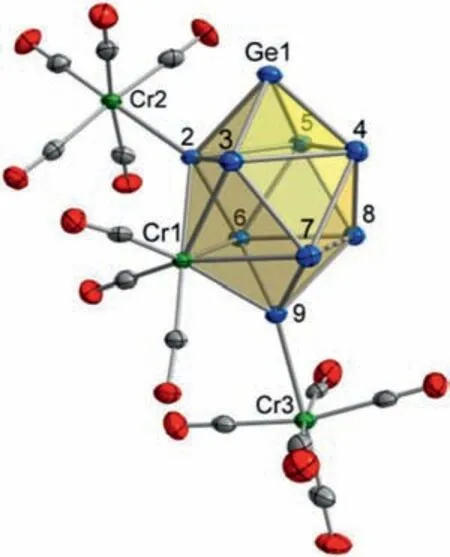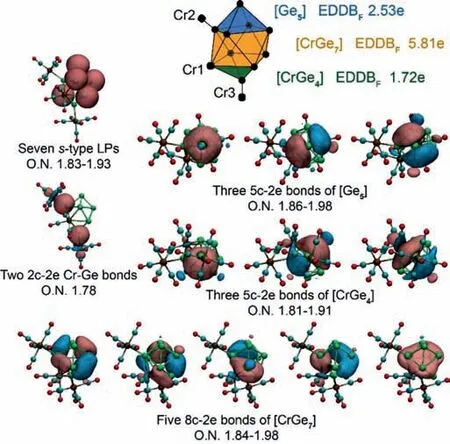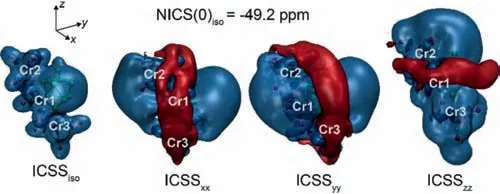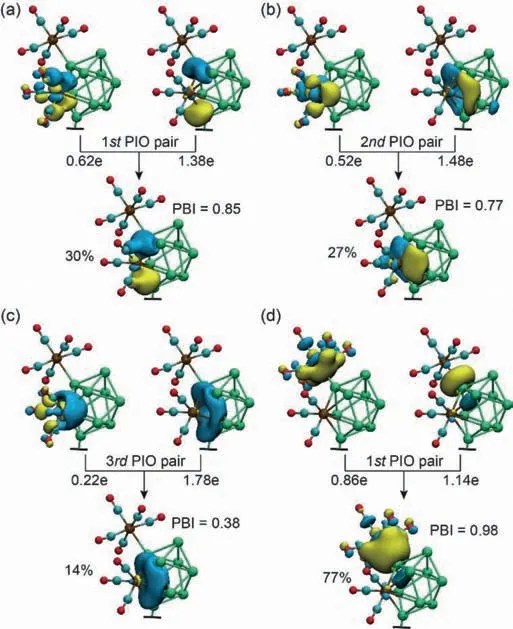[(CrGe9)Cr2(CO)13]4-:A disubstituted case of ten-vertex closo cluster with spherical aromaticity
Y-Shn Hung,Dndn Chen,Jun Zhu,Zhong-Ming Sun,*
a State Key Laboratory of Elemento-Organic Chemistry,Tianjin Key Lab of Rare Earth Materials and Applications,School of Material Science and Engineering,Nankai University,Tianjin 300350,China
b State Key Laboratory of Physical Chemistry of Solid Surfaces,Collaborative Innovation Center of Chemistry for Energy Materials(iChEM),College of Chemistry and Chemical Engineering,Xiamen University,Xiamen 361005,China
ABSTRACT We report the first disubstituted hetero-ten-vertex closo cluster[(CrGe9)Cr2(CO)13]4- with three adjacent Cr(CO)n units adopting both η5 and η1 coordination modes,which was synthesized through the reaction of“KGe1.67”with(MeCN)3Cr(CO)3 and Cr(CO)6 in ethylenediamine(en)solution.In contrast to the η1-Cr atoms forming localized two-center two-elelctron(2c-2e)Cr-Ge bonds,the hetero atom η5-Cr exhibits versatile bonding mechanisms including three 5c-2e and five 8c-2e delocalized bonds which account for Hückel aromaticity.Intricate multi-center bonding patterns delineate the multiple local σ-aromatic characters of the title cluster displaying explicit spherical aromaticity.
Keywords:Hetero-ten-atom clusters Closo structure Functionalization Multi-center bonding Spherical aromaticity
The chemistry of Grou p 14 zintl ions covers extensive studies of nine-atom deltahedral clusters,whereas those of ten-atomclosoclusters remain relatively limited[1-10].Albeit two homoatomic clusters E102-(E = Ge,Pb)have been isolated from solution reactions[11,12],most of the structurally characterized ten-atom clusters are doped with at least one metal atom.At variance with most heteroatomic clusters capped by transition-metal fragments,such as[(η4-E9)M(CO)3]4-(E = Sn,Pb;M=Cr,Mo,W)[13,14],[E9Zn-Ph]3-(E = Si,Ge,Sn,Pb)[15],[NHCDippMSn9]3-(M = Cu,Ag,Au)[16],[E9Cd(C6H5)]3-(E = Sn,Pb)[17]and[Ge9Ni-CO]3-[18],alternative coordination modes have been observed,for example,one Mo(CO)3fragment in the[(η5-Pb9)Mo(CO)3]4-occupying a waist vertex[19].Recently,another ten-vertex cluster[Ge8(Mo(CO)3)2]4-with two waist vertices replaced by Mo(CO)3fragments has also been reported[20].The inherent stability ofclosoarchitecture imparts to elusive substitution on such type of clusters.Not much has been known about the functionalized clusters,since only one monosubstituted ten-vertex cluster[Ge10Mn(CO)4]3-was isolated[21].Herein,we report the isolation of a disubstituted hetero ten-vertexclosocluster derivative[K(2.2.2-crypt)]4[(CrGe9)Cr2(CO)13]·tol(1).Structural characterization and calculations revealed an unusual arrangement of three adjacent Cr(CO)nfragments,wherein bothη5andη1coordination modes jointly interpret the sophisticated bonding pattern which further leads to multiple local aromaticity in the title cluster.
The title cluster[(CrGe9)Cr2(CO)13]4-(1a,Fig.1)was obtained from the reaction of“KGe1.67”with(MeCN)3Cr(CO)3and Cr(CO)6in en in the presence of 2.2.2-crypt.Single-crystal X-ray diffraction reveals that the complex crystallizes in the triclinic space groupP1 and the asymmetric unit contains one crystallographically distinct 1a with four[K(2.2.2-crypt)]+cations as well as one solvent molecule of toluene,and an interaction was observed between one carbonyl group of 1a and[K(2.2.2-crypt)]+(Fig.S2 in Supporting information).
Strong signals of the parent anions {H[K(2.2.2-crypt)]2[Ge9Cr3(CO)13]}-and {H2[K(2.2.2-crypt)][Ge9Cr3(CO)13]}-(Fig.2 and Fig.S6 in Supporting information)were observed in the electrospray ionization mass spectra(ESI-MS)of 1 in DMF.In addition,the ESIMS revealed a signal of {H2[K(2.2.2-crypt)][Ge9Cr2(CO)8]}-(Fig.S5 in Supporting information)ion losing one Cr(CO)5fragment.The successful isolation of the[(η5-Pb9)Mo(CO)3]4–reminded us the possible existence of[(η5-Ge9)Cr(CO)3]4–.However,all attempts to obtain[Ge9Cr2(CO)8]4-and[(η5-Ge9)Cr(CO)3]4–by changing the precursor and reaction conditions proved unsuccessful.
The structure of[(CrGe9)Cr2(CO)13]4-is best described as a hetero-ten-atomclosocluster[CrGe9]with a waist vertex occupied by the Cr(CO)3and two coordinated Cr(CO)5fragments on the positions of Ge2 and Ge9 inη1:η1-coordination modes.Not only the shape of[CrGe9]defines it as aclosocluster but its charge and electron count.The anionic cluster 1a with a total of 22 skeleton electrons,provided by 9 Ge-atoms(2 electrons each)and one Cr(CO)3fragment(0 electron)as well as the charge(4 additional electrons),is in accordance with the Wade-Mingos rules for a tenatomclosocluster[22,23].

Fig.1.Structure of[(CrGe9)Cr2(CO)13]4-(1a)(thermal ellipsoids of heavy atoms drawn at 50% probability).DFT-optimized bond distances are available in Supporting information.

Fig.2.Negative ion mode ESI mass peak corresponding to {H[K(2.2.2-crypt)]2[Ge9Cr3(CO)13]}-.The recorded experimental data is shown in black with the calculated isotopic distributions in red.
Insertion of the Cr(CO)3fragment results in the distorted tenvertex cage with a compressed Ge4square(2.6659(11)-2.8670(11)˚A)and an extended CrGe3square(2.8104(12)-3.0324(12)˚A).The Ge-Ge distances range from 2.5073(11)˚A to 2.8670(11)˚A and are comparable to those observed in other germanium clusters[24–31].The very long Cr-Ge bond distances(Cr1-Ge6/Cr1-Ge7:2.8814(13)˚A /2.9061(14)˚A)are located in the extended CrGe3-square,while the shortest(Cr1-Ge9:2.5199(14)˚A)is the bond between the Cr-vertex and the Ge-atom exo-bonded to Cr(CO)5,only 0.02-0.06 ˚A shorter than other distances at the exo-bonded germanium atoms(Cr3-Ge9/Cr1-Ge2/Cr2-Ge2:2.5413(14)˚A/2.5571(14)˚A/2.5824(14)˚A).Overall,the Cr-Ge bond distances in 1a span a wider range compared with those in the reported cluster Ge9[Si(SiMe3)3]3Cr(CO)3-(2.6462(13)-2.6957(14)˚A)[32].

Fig.3.AdNDP and EDDB results for 1a.Isovalue:0.03.EDDBF is the EDDB calculated for a fragment excluding external resonance effects.Levels of theory:PBE0/ma-TZVP for AdNDP,and CAM-B3LYP/ma-TZVP//PBE0/ma-TZVP for EDDB.

Fig.4.Magnetic responses of 1a showing spherical aromatic characters.Blue,red isosurfaces correspond to shielding and deshielding effects.Isovalue:3.0.Level:B3LYP/def2-SVP.
DFT calculations at the PBE0/ma-TZVP level revealed distinct bonding modes ofη5-Cr(CO)3andη1-Cr(CO)5in 1a[33–36].The valence-electron count for hetero cage[Cr(Ge9)]4-is 40,ascribed to 36 electrons from nine Ge atoms and 4 negative charges.An adaptive natural density partitioning(AdNDP)scheme consisting of 7 lone pairs(LPs)of Ge atoms[37,38],2 two-center two-electron(2c-2e)Cr-Ge bonds formed by the exo-bonded Ge2/Ge9 and theη1-Cr2/Cr3,and multi-center units([Ge5],[CrGe7],[CrGe4])that partition the cage into three aromatic regions(Fig.3).The[CrGe4]is capped by[Ge5]and[CrGe7]at opposite positions.Both[Ge5]and[CrGe4]have three five-center two-electron bonds that account for 5c-6eσaromaticity,while[CrGe7]is 8c-10eσ-aromatic with 5 eight-center two-electron bonds[39,40].All three units follow the Hückel 4n+2 rule(n= 1 for 5c-6e andn= 2 for 8c-10e).Taking into account the external resonance effects,the electron density of delocalized bonds(EDDB)of the[CrGe9]4-cage is 15.62e which is 71% of the total 22e from two 5c-6e and one 8c-10e aromatic systems and comparable to the degree of delocalization in all-metal aromatics such as3Li3Al4-and3Be2B6[41,42].Considering only local resonances(Fig.3),the EDDBFcalculated for[Ge5](2.53e,0.51e per atom),[CrGe7]5.81e(0.73e per atom)and[CrGe4](1.72e,0.34e per atom)indicate the delocalization is stronger within the[CrGe7]unit and weaker for the[CrGe4]where the atomic contribution(Fig.S9 in Supporting information)of Cr1(0.20e)is smaller than those of four Ge atoms(0.28-0.61e).
Hence,the[Cr(Ge9)]4-can be considered an overall spherical aromatic hetero cage featuring three localσ-aromatic units[43,44].The iso-chemical-shielding surfaces(ICSS)demonstrate magnetic shielding cones along three canonical directions(x,y,z)regardless of the irregular shapes caused by the interference ofη1-Cr atoms and CO ligands(Fig.4),similar to the typical response of spherical aromatic species under an external magnetic field[45,46].Nucleus-independent chemical shift(NICS)at the geometry center is considerably negative(-49.2 ppm)with components NICSxx,NICSyy,and NICSzzbeing-62.1 ppm,-51.5 ppm and-34.0 ppm[47],respectively,further supporting the significant aromaticity of[Cr(Ge9)]4-.

Fig.5.Principle interacting orbital(PIO)analyses on 1a using η5-Cr(CO)3 and Ge9Cr2(CO)10 as fragments in(a-c),and η1-Cr2(CO)5 and Cr(CO)3Ge9Cr(CO)5 as fragments in(d).The top three PIO pairs contribute 30%+27%+14% = 71% of total interaction between the η5-Cr1 and the rest part of the cage.PBI:PIO-based bond index.Isovalue for surfaces:0.05 a.u.
Although the AdNDP scheme for 1a suggests that theη5-Cr1 participates in the multi-center bonding in both[CrGe7]and[CrGe4]units,the interaction between Cr1 and five adjacent Ge atoms can be represented by three principle interacting molecular orbitals(PIMOs)(Figs.5a-c)which are also well delocalized within the corresponding[Cr1Ge5]unit which could be considered 6c-6eσ-aromatic with 2.31e of EDDBF(0.38e per atom)[48,49].The multi-center bonds of[Cr1Ge5]do not belong to the proposed AdNDP scheme,however,neither do they contradict the latter because the different manifestations of local aromaticity actually root in the same system with complicated resonance effects.On the other hand,theη1-Cr2/Cr3 forms only localized 2c-2e bonds with Ge atoms(Fig.5d).
In conclusion,we report the synthesis and characterization of[(CrGe9)Cr2(CO)13]4-,a difunctionalized ten-vertex Zintl cluster where oneη5-Cr(CO)3and twoη1-Cr(CO)5adopt entirely different bonding modes in the interaction with the Ge9moiety.Within an AdNDP scheme with well-partitioned valence-electrons,theη5-Cr1 serves as a member of both the 5c-6e[CrGe4]and the 8c-10e[CrGe7]σ-aromatic systems while the 5c-6e[Ge5]accounts for the rest multi-center bonds in 1a.Analyses of magnetic response and electron delocalization confirmed the spherical aromatic character of 1a.Focusing on the bonding betweenη5-Cr(CO)3and the remaining moiety of 1a,we found three 6c-2e bonds that could result in another localσ-aromatic unit which is the Cr[Ge5]containing theη5-Cr1.In contrast,theη1-Cr2 andη1-Cr3 are attached to the hetero ten-atom cage[CrGe9]4-viaonly localized 2c-2e Cr-Ge bonds.Our findings demonstrate the first synthesis of a disubstituted hetero-ten-vertexclosocage,[(CrGe9)Cr2(CO)13]4-,with the sophisticated bonding patterns and aromatic characters disclosed.
Declaration of competing interest
The authors declare that they have no known competing financial interests or personal relationships that could have appeared to influence the work reported in this paper.
Acknowledgments
This work was supported by the National Natural Science Foundation of China(No.21971118 to Z.M.Sun and21573179 to J.Zhu)and the Natural Science Foundation of Tianjin City(No.20JCYBJC01560)
Supplementary materials
Supplementary material associated with this article can be found,in the online version,at doi:10.1016/j.cclet.2021.08.038.
 Chinese Chemical Letters2022年4期
Chinese Chemical Letters2022年4期
- Chinese Chemical Letters的其它文章
- Key progresses of MOE key laboratory of macromolecular synthesis and functionalization in 2020
- Small nanoparticles bring big prospect:The synthesis,modification,photoluminescence and sensing applications of carbon dots
- Cell membrane-coated nanoparticles for immunotherapy
- Diketopyrrolopyrrole-derived organic small molecular dyes for tumor phototheranostics
- Exosome based miRNA delivery strategy for disease treatment
- Recent advances in targeted stimuli-responsive nano-based drug delivery systems combating atherosclerosis
